Brian Clegg's Blog, page 65
October 9, 2015
A Lonely Height
 Although I primarily deal in non-fiction I've always written both science fiction and detective fiction as well, and I'm delighted to say that I've finally got round to making the first of my murder mysteries featuring Stephen Capel available to buy.
Although I primarily deal in non-fiction I've always written both science fiction and detective fiction as well, and I'm delighted to say that I've finally got round to making the first of my murder mysteries featuring Stephen Capel available to buy.A Lonely Height begins with a body being found on top of Glastonbury Tor, in the ruined church tower. But remarkably, on a dry summer day, in the highest spot for miles around, the victim was drowned. The body is discovered by Stephen Capel, a newly appointed vicar, who is in Glastonbury on a course. As he uncovers the mystery behind the death, discovering a link with the earlier death of a celebrity photographer and becoming involved in a complex web of relationships, Capel meets and falls for Vicky Denning, a WPC working on the case... and comes face to face with his own mortality.
I wrote the novel a few years ago and never got round to doing anything with it, so have finally got it into published form and it has been great for me getting back to it. After a few years when pretty well every murder mystery seemed to involve graphic horror, often in a dark Scandinavian setting, I hope that readers will find a return to the classic British form attractive and entertaining. And let's face it, it is the ideal time of year to curl up with a good murder mystery.
A Lonely Height is available as a paperback for £6.99 from Amazon.co.uk and at $9.99 from Amazon.com, and as a Kindle ebook for a bargain £1.99 from Amazon.co.uk or $3.01 from Amazon.com. We are talking less than a cup of coffee here... well worth a try.
Published on October 09, 2015 01:46
October 8, 2015
Bag for Life Top Trumps revisited
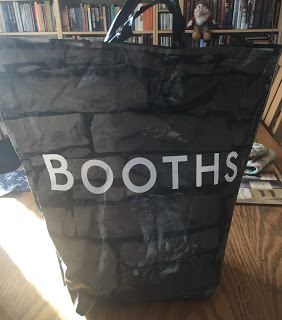 Now that England has joined other parts of the UK in charging 5p for a 'single use'* shopping bag, I thought it was worth revisiting a middle class game I brought up a while ago, especially as I have since discovered an additional, powerful card to add to the pack.
Now that England has joined other parts of the UK in charging 5p for a 'single use'* shopping bag, I thought it was worth revisiting a middle class game I brought up a while ago, especially as I have since discovered an additional, powerful card to add to the pack.As someone with green aspirations (come on, I did write Ecologic ), I'm all in favour of supermarket 'bag for life' offerings, which mean you reuse your bags rather than throw them away. However, I think it is boring, and quite possibly in bad taste, to use a bag in the shop from which it was obtained.
Instead, to keep the shopping experience amusing, the good middle class shopper should play a game of Bag-for-life Top Trumps®. The idea is simple. Always use a bag with snob value at the supermarket in which you are shopping. So:
In Aldi/Lidl use at least an Asda bag**In Asda use at least a Tesco bagIn Tesco use at least a Sainsbury's bagIn Sainsbury's use at least a Marks and Spencer bagIn Marks and Spencer use at least a Waitrose bagIn Waitrose use at least a Booths bagIn my previous list, Waitrose was top of the food chain (geddit?), but I have since discovered the North West-only chain Booths, which makes Waitrose look common.
But there is still the final problem. What to do in that doyen of supermarkets? Not a problem at all, because there is one bag that trumps them all - a French supermarket bag. In fact it's best to stick to one of these at any store, then you don't have to worry about whether you are properly attired. You can turn up in your pyjamas, a deer stalker and a tutu and still feel superior.
* I'm always a bit wary of the term 'single use'. There's no doubt that this kind of usage tax does significantly reduce the number of 'single use' bags issued by supermarkets, which sounds very green. However, there was some evidence from Ireland, when this approach was introduced there, that the consumption of the plastic film going into plastic bags went up, not down. This is because many people actually re-use 'single use' bags for other purposes, e.g. bin bags, food bags etc. As they then had to buy 'real' bin bags etc., which typically use significantly more plastic than the equivalent 'single use' bag, the impact seemed to be to actually increase the plastic (by weight) going into waste.
** Having said that, there's a bit of inverse snobbery that means that bags from really cheap places have a slight cachet that lets them play up a level or two. But they still don't work at Marks and Spencers and above.
Published on October 08, 2015 01:46
October 7, 2015
The Fellowship of the RLF
 My new home-from-home, the Biomedical Sciences buildingI am now in my third week of an RLF Fellowship, so it seems a good point to comment on this remarkable institution and its work.
My new home-from-home, the Biomedical Sciences buildingI am now in my third week of an RLF Fellowship, so it seems a good point to comment on this remarkable institution and its work.The Royal Literary Fund is a charity that was set up in the eighteenth century to support starving authors - and it still helps those in difficulty today, but arguably its more prominent role is now educational. The fund now has Fellows, who are professional writers, in over 50 UK universities and similar institutions (you can see an impressive map of where they are here), where their role is to help students and staff improve the quality of their writing.
I'm one of two Fellows in the Science faculty at the University of Bristol, working alongside short story writer and poet Tania Hershman, and so far a summary of the experience would be 'exhausting but brilliant.'
 Need to get right to the top of the road as seen hereThe exhausting part is partially because after 20 years of working for myself I'm not used to doing a proper job (at least that's what some might say), and partly because getting to our base in the Biomedical Sciences building involves a climb up the south face of St Michael's Hill, an ascent that I'm sure most professional climbers would not attempt without all the right gear (though students do power past me with monotonous regularity).
Need to get right to the top of the road as seen hereThe exhausting part is partially because after 20 years of working for myself I'm not used to doing a proper job (at least that's what some might say), and partly because getting to our base in the Biomedical Sciences building involves a climb up the south face of St Michael's Hill, an ascent that I'm sure most professional climbers would not attempt without all the right gear (though students do power past me with monotonous regularity). As for the brilliant part, it is extremely rewarding when it's possible to help someone with their writing - and its hard to imagine a more welcoming faculty. It's only early days, but I think this was a good project to take on.
Published on October 07, 2015 01:21
October 4, 2015
The joys of Man
N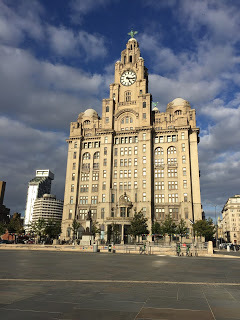 A week or so ago I went to the best literary festival I've ever attended. It wasn't a five ring circus like Hay, but rather a compact but imaginative mix of authors, not just speaking at events (several of them free because they were sponsored), but also spending a day in local schools. The only other festival I've ever spoken at that had the same sense of community was the marvellous Kempsford Festival in Gloucestershire. That one demonstrated that small is beautiful, while the Manx Litfest proved that you could be bigger and still have that essential link to the community.
A week or so ago I went to the best literary festival I've ever attended. It wasn't a five ring circus like Hay, but rather a compact but imaginative mix of authors, not just speaking at events (several of them free because they were sponsored), but also spending a day in local schools. The only other festival I've ever spoken at that had the same sense of community was the marvellous Kempsford Festival in Gloucestershire. That one demonstrated that small is beautiful, while the Manx Litfest proved that you could be bigger and still have that essential link to the community.
Of course, the location helped. Getting to the Isle of Man is not a trivial exercise, especially if, like me, you choose to avoid flying and instead opt for three trains and a ferry - total journey time around 9 hours. But, of course, the great thing about travelling this way is you can work as you do, so it's not wasted time. And it was an opportunity, as I walked to the ferry, to see the Liver Building in all its glory like this.
 To be fair, the island itself was on its best behaviour and gave us beautifully sunny days that meant my early morning view on the Friday, taken from the porch of the hotel, could have been the South of France. Instead, though, I was heading off to visit to Manx schools, in the morning at the Cronk-y-Berry junior school with a group of hugely enthusiastic year fours, and then off to Ballakermeen high school, where I not only had a theatre full of positive audience but the opportunity to sample the island delicacy at lunchtime. Sadly I chickened out from the chips, cheese and gravy - I should have been braver.
To be fair, the island itself was on its best behaviour and gave us beautifully sunny days that meant my early morning view on the Friday, taken from the porch of the hotel, could have been the South of France. Instead, though, I was heading off to visit to Manx schools, in the morning at the Cronk-y-Berry junior school with a group of hugely enthusiastic year fours, and then off to Ballakermeen high school, where I not only had a theatre full of positive audience but the opportunity to sample the island delicacy at lunchtime. Sadly I chickened out from the chips, cheese and gravy - I should have been braver.
 After a quick sandwich it was off again for the evening engagement which combined a talk by Matthew Kneale about his father, Nigel and the showing of two of Nigel Kneale's Quatermass episodes - the first of the Quatermass Experiment and of Quatermass and the Pit. I had the privilege of joining Matthew on stage part way through for a quick chat about science and science fiction, and a chance to ask him some questions in front of the audience (I'm the one in the left hand chair, with Matthew on the right and festival director John Quirke at the podium.) British TV and film science fiction was hugely influenced by Quatermass and despite the fuzzy black and white, there was real class in these productions. After Quatermass and the Pit particularly I would have loved to have watched more of the story.
After a quick sandwich it was off again for the evening engagement which combined a talk by Matthew Kneale about his father, Nigel and the showing of two of Nigel Kneale's Quatermass episodes - the first of the Quatermass Experiment and of Quatermass and the Pit. I had the privilege of joining Matthew on stage part way through for a quick chat about science and science fiction, and a chance to ask him some questions in front of the audience (I'm the one in the left hand chair, with Matthew on the right and festival director John Quirke at the podium.) British TV and film science fiction was hugely influenced by Quatermass and despite the fuzzy black and white, there was real class in these productions. After Quatermass and the Pit particularly I would have loved to have watched more of the story.
At a drink afterwards with Matthew, John and others, Harry from the conference bookshop, Bridge Bookshop, asked a question no one brought up at the event, but an essential bit of info for any history of science fiction buff - where did that distinctive name 'Quatermass' come from? Apparently Nigel Kneale flicked through a London phone directory and the name caught his eye - there was just one in the directory.
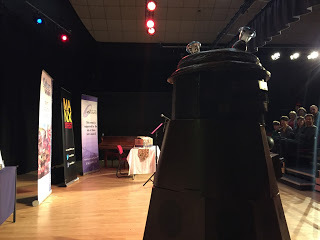 The next day I had a free morning to stroll along the prom and prepare for my session on Build Your Own Time Machine. In the photo I'm just waiting to go on, seated behind a dalek (as you would be). Sadly the TARDIS that we'd hoped to have a stage prop was too big to fit on the trailer provided, so I had to make do with my standby prop, the cardboard box of time.
The next day I had a free morning to stroll along the prom and prepare for my session on Build Your Own Time Machine. In the photo I'm just waiting to go on, seated behind a dalek (as you would be). Sadly the TARDIS that we'd hoped to have a stage prop was too big to fit on the trailer provided, so I had to make do with my standby prop, the cardboard box of time.
After my event I was whisked off for a chance to be a fan in the audience for a talk by Joanne Harris of Chocolat fame - it was fascinating to hear about her early inspiration in the Barnsley library and her new title, The Gospel of Loki , which as a re-telling of the Norse legends from Loki's viewpoint is about as far from the Chocolat image as you could imagine.
A recovering evening followed before an early ferry back to the mainland. All in all, a great festival.
 A week or so ago I went to the best literary festival I've ever attended. It wasn't a five ring circus like Hay, but rather a compact but imaginative mix of authors, not just speaking at events (several of them free because they were sponsored), but also spending a day in local schools. The only other festival I've ever spoken at that had the same sense of community was the marvellous Kempsford Festival in Gloucestershire. That one demonstrated that small is beautiful, while the Manx Litfest proved that you could be bigger and still have that essential link to the community.
A week or so ago I went to the best literary festival I've ever attended. It wasn't a five ring circus like Hay, but rather a compact but imaginative mix of authors, not just speaking at events (several of them free because they were sponsored), but also spending a day in local schools. The only other festival I've ever spoken at that had the same sense of community was the marvellous Kempsford Festival in Gloucestershire. That one demonstrated that small is beautiful, while the Manx Litfest proved that you could be bigger and still have that essential link to the community.Of course, the location helped. Getting to the Isle of Man is not a trivial exercise, especially if, like me, you choose to avoid flying and instead opt for three trains and a ferry - total journey time around 9 hours. But, of course, the great thing about travelling this way is you can work as you do, so it's not wasted time. And it was an opportunity, as I walked to the ferry, to see the Liver Building in all its glory like this.
 To be fair, the island itself was on its best behaviour and gave us beautifully sunny days that meant my early morning view on the Friday, taken from the porch of the hotel, could have been the South of France. Instead, though, I was heading off to visit to Manx schools, in the morning at the Cronk-y-Berry junior school with a group of hugely enthusiastic year fours, and then off to Ballakermeen high school, where I not only had a theatre full of positive audience but the opportunity to sample the island delicacy at lunchtime. Sadly I chickened out from the chips, cheese and gravy - I should have been braver.
To be fair, the island itself was on its best behaviour and gave us beautifully sunny days that meant my early morning view on the Friday, taken from the porch of the hotel, could have been the South of France. Instead, though, I was heading off to visit to Manx schools, in the morning at the Cronk-y-Berry junior school with a group of hugely enthusiastic year fours, and then off to Ballakermeen high school, where I not only had a theatre full of positive audience but the opportunity to sample the island delicacy at lunchtime. Sadly I chickened out from the chips, cheese and gravy - I should have been braver. After a quick sandwich it was off again for the evening engagement which combined a talk by Matthew Kneale about his father, Nigel and the showing of two of Nigel Kneale's Quatermass episodes - the first of the Quatermass Experiment and of Quatermass and the Pit. I had the privilege of joining Matthew on stage part way through for a quick chat about science and science fiction, and a chance to ask him some questions in front of the audience (I'm the one in the left hand chair, with Matthew on the right and festival director John Quirke at the podium.) British TV and film science fiction was hugely influenced by Quatermass and despite the fuzzy black and white, there was real class in these productions. After Quatermass and the Pit particularly I would have loved to have watched more of the story.
After a quick sandwich it was off again for the evening engagement which combined a talk by Matthew Kneale about his father, Nigel and the showing of two of Nigel Kneale's Quatermass episodes - the first of the Quatermass Experiment and of Quatermass and the Pit. I had the privilege of joining Matthew on stage part way through for a quick chat about science and science fiction, and a chance to ask him some questions in front of the audience (I'm the one in the left hand chair, with Matthew on the right and festival director John Quirke at the podium.) British TV and film science fiction was hugely influenced by Quatermass and despite the fuzzy black and white, there was real class in these productions. After Quatermass and the Pit particularly I would have loved to have watched more of the story.At a drink afterwards with Matthew, John and others, Harry from the conference bookshop, Bridge Bookshop, asked a question no one brought up at the event, but an essential bit of info for any history of science fiction buff - where did that distinctive name 'Quatermass' come from? Apparently Nigel Kneale flicked through a London phone directory and the name caught his eye - there was just one in the directory.
 The next day I had a free morning to stroll along the prom and prepare for my session on Build Your Own Time Machine. In the photo I'm just waiting to go on, seated behind a dalek (as you would be). Sadly the TARDIS that we'd hoped to have a stage prop was too big to fit on the trailer provided, so I had to make do with my standby prop, the cardboard box of time.
The next day I had a free morning to stroll along the prom and prepare for my session on Build Your Own Time Machine. In the photo I'm just waiting to go on, seated behind a dalek (as you would be). Sadly the TARDIS that we'd hoped to have a stage prop was too big to fit on the trailer provided, so I had to make do with my standby prop, the cardboard box of time.After my event I was whisked off for a chance to be a fan in the audience for a talk by Joanne Harris of Chocolat fame - it was fascinating to hear about her early inspiration in the Barnsley library and her new title, The Gospel of Loki , which as a re-telling of the Norse legends from Loki's viewpoint is about as far from the Chocolat image as you could imagine.
A recovering evening followed before an early ferry back to the mainland. All in all, a great festival.
Published on October 04, 2015 23:09
October 1, 2015
Weird Wessex review
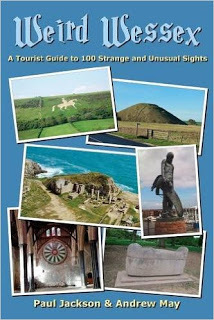 When I was a teenager I absolutely loved guidebooks to weird and wonderful aspects of Britain, and though I haven't looked at one in a long time, Weird Wessex, by Paul Jackson and Andrew May, brought it all back, with its enticing combination of very ordinary British locations and very strange buildings, monuments and legends.
When I was a teenager I absolutely loved guidebooks to weird and wonderful aspects of Britain, and though I haven't looked at one in a long time, Weird Wessex, by Paul Jackson and Andrew May, brought it all back, with its enticing combination of very ordinary British locations and very strange buildings, monuments and legends.The book consists of a series of short, factual illustrated articles. These don't tend to have too much narrative, concentrating primarily on being informative. Sometimes I felt that the text was too short - for instance, the Stonehenge section doesn't mention the increasingly strong evidence that the monument's most significant alignment is mid-winter, with the mid-summer alignment mentioned in the text being little more than an inevitable side-effect.
I did spot a minor error (or possibly sanitisation) - we're told Mary Wollstonecraft Godwin married Shelley in 1814. In reality this was the year that they began their relationship, and they didn't marry until 1816 (apart from anything else, Shelley was married to Harriet Westbrook until her death in December 1816). Interestingly Mary didn't marry until several months after the trip to Italy when she first came up with the Frankenstein idea and started the story.
The articles in Weird Wessex are divided into somewhat arbitrary sections like 'Weird History' and 'Weird Landscape', but there are lots of fun, interesting topics. I've always found the most interesting aspect of books like this are not the big ticket destinations like Stonehenge or Wells Cathedral, both of which appear, but the little oddities like the Langton Cross which apparently, according to legend, travels a mile each New Years Eve. These are destinations that you have to go out of your way to find, or perhaps even need to uncover from the undergrowth, and are all the more fun for it. Luckily, this well-illustrated little book contains a true plethora of these delightful oddities.
Weird Wessex is available on Amazon.co.uk and Amazon.com.
Published on October 01, 2015 03:19
September 30, 2015
Superconducting ship wrecked
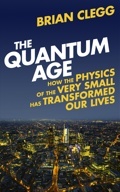 One of the dangers of being a science writer is that I'm not a working scientist in the fields I write about, and though I try to make sure my facts are up to scratch, there will always be errors that slip through the net. Luckily, readers are good at spotting these, and email me to point them out.
One of the dangers of being a science writer is that I'm not a working scientist in the fields I write about, and though I try to make sure my facts are up to scratch, there will always be errors that slip through the net. Luckily, readers are good at spotting these, and email me to point them out.I've had an email from a reader who say that he enjoyed reading my book on quantum physics and its applications, The Quantum Age , but identified an error when I was talking about the use of electric motors in ships.
In the book, I said existing electric motors simply can’t be scaled up to the size required to power a full-sized ocean-going ship. I had misread an Institute of Physics report, saying that its not possible to have low transmission loss motors at this scale, not that it’s not possible to have them at all. As my correspondent pointed out:
Electric motors have been used for ship propulsion since the 19th century.What I should have said is that existing electric motors suffer from high transmission losses when scaled up to the size required for a full-sized ocean-going ship.
In 1987 the QE2 was fitted with 2 x 44MW electric motors driving variable pitch propellers. The motors were built at the GEC factory in Rugby .The Type 45 destroyers for the Royal Navy all have integrated full electric propulsion (IFEP) as do the new Queen Elizabeth Class aircraft carriers.Most cruise liners use podded electric motors with full azimuthing capability to provide both propulsion and steering. The QM2 has 4 x 21.5MW podded electric motors built by ALSTOM. All submarines use electric propulsion.In Rugby we developed a 5MW superconducting motor, and made a contribution to the development of a 36MW superconducting motor for the US Navy for ship propulsion.
Thanks again to my correspondent for pointing this out.
Published on September 30, 2015 02:45
September 29, 2015
The Gospel of Loki review
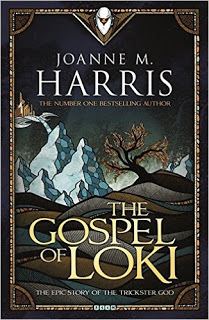 One of the best things about speaking at the recent Manx Litfest (of which more soon) was attending some of the other author events, including one by Joanne Harris, talking about her new book The Gospel of Loki.
One of the best things about speaking at the recent Manx Litfest (of which more soon) was attending some of the other author events, including one by Joanne Harris, talking about her new book The Gospel of Loki.This is a beautifully conceived bit of fantasy writing. The idea is that we already have the 'authorised version' of the history of the Norse gods, as provided primarily by Odin in the form of the familiar Norse myths, but inevitably they are biased to Odin's viewpoint. This book is the version according to Loki, traditionally the bad guy in the myths. Of course, Loki is an inveterate liar and trickster, so it's essential to take his words with a pinch of salt, but they are all the more entertaining because of this.
Harris sets out to get under the skin of this archetypal villain, to see why he might have acted the way the myths have him behave. Apparently some fans (particularly US fans of the comic book version) have complained because it's 'not canon' - but for me this is the delight and appeal of this book, especially because Loki has a very modern way of expressing himself.
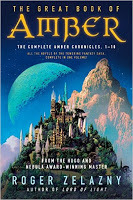 Although I was vaguely aware of the Norse myths, I had no idea until I read The Gospel how much Roger Zelazny was clearly inspired by the Norse material for his classic Amber series - not in an explicit way, but strongly coming through in the two power centres of Order (Amber) and Chaos, with the shadow worlds in between, and in the way that the ruling houses act in so many details.
Although I was vaguely aware of the Norse myths, I had no idea until I read The Gospel how much Roger Zelazny was clearly inspired by the Norse material for his classic Amber series - not in an explicit way, but strongly coming through in the two power centres of Order (Amber) and Chaos, with the shadow worlds in between, and in the way that the ruling houses act in so many details.Having said that, there's plenty that's original in the Amber books, and if you've never read them, I strongly recommend getting hold of a copy of them too. In fact, I can't help but wonder if Harris was slightly inspired by them herself, because Zelazny also makes full use of the opportunities to contrast a modern world first person narrator's viewpoint with the more ancient feeling universes, including the narrator's experience of being imprisoned and blinded.
So, a big recommendation for Joanne Harris's new book. It proved quite a pleasant shock to me, as (and I suspect this may be the case with most people) I only associated her with her best-known novel Chocolat, but this is a very different, earthy and delightful style. The Gospel of Loki is available on Amazon.co.uk and Amazon.com. It's also well worth taking at look at The Great Book of Amber on Amazon.co.uk and Amazon.com.
Published on September 29, 2015 05:05
September 24, 2015
Dr Bayes' medical marvels
 The Bayesian approach to statistics is a fascinating subject, which I cover at some length in my book
Dice World
. What Bayes theorem enables you to do is to improve an estimate of the chances of something happening when you have additional information, and to use one set of probabilities to calculate another linked one.
The Bayesian approach to statistics is a fascinating subject, which I cover at some length in my book
Dice World
. What Bayes theorem enables you to do is to improve an estimate of the chances of something happening when you have additional information, and to use one set of probabilities to calculate another linked one.This can be extremely useful and powerful when, for instance, calculating the effectiveness of disease screening tests, which can be very confusing due to wildly varying conditional probabilities. It's worth getting your head around a bit of probability symbology to get on top of this. In these simple formulae, the '|' sign is read as 'given'.
So, for instance if I have a test that will flag up the presence of a disease 90% of the time, which isn't too bad, I can write that as
P (Positive result | Disease ) = 90% - the probability of a positive result in the test, given the person has the disease, is 90%.
The problem comes, and sadly this has happened for real, when this is represented by the medical profession or (more often) the press office of a university or the press in general as the test being '90% accurate.' This is because it's perfectly possible with the same test for P (Disease | Positive Result ) to be, say, just 20%.
What that's saying is that the probability of a person who tested positive having the disease is only 20%. This, of course, is an important part of what people want to know after a test. I've just had the test and it came up positive. What's the chance that I actually have the disease? In this case it is surprisingly low, given the apparent 'accuracy' of the test.
The reason this can happen is that to work out the first figure, P (Positive result | Disease ) we are only considering the population of people who have the disease, which might be quite small. But for the second figure, P (Disease | Positive Result) we are looking at the population who had the test, which could be a much bigger number, overwhelming the number of correct positive result tests from the smaller population of sufferers with the false positive result tests from the larger population of tested people.
This makes those in the business who understand probability wary of mass screening programmes for relatively rare conditions - they result in tests that, even when very likely to get the result right on any particular individual, can come up with a distressing false positive more often than a true outcome, putting the patient through a time of horrible stress unnecessarily.
See David Colquhoun's blog for more detail on the risks of using these kinds of screening tests.
Published on September 24, 2015 02:40
September 21, 2015
Trivia is supposed to be fun, not news
 Two news stories have really irritated me this weekend, and since one is anti-Labour and one is anti-Tory, we even have a good, BBC-style, political balance.
Two news stories have really irritated me this weekend, and since one is anti-Labour and one is anti-Tory, we even have a good, BBC-style, political balance.The first was the press outrage that the Leader of the Opposition, Jeremy Corbyn, was not going to attend a rugby match. I'm sorry, it's a game. Get over it. I don't give a stuff. I want my politicians sorting out important political stuff, not acting as celebrities by turning up at some event that has no significance whatsoever.
The second is that the Prime Minister, David Cameron, may have done something stupid as a young man involving a dead pig. (If you want to see some magnificent, but sometimes amusing over-reaction, take a look at the hashtag #piggate on Twitter.) This is doubly crass. First, once again, I want a senior politician focussed on the serious problems that the country and the world face, not on a silly story. But also how many of us can honestly say 'I never did something stupid between the ages of 15 and 25'?
I certainly can't. While I can assure my readers I never had anything dubious to do with dead pigs (or any other animals, dead or alive) I certainly did some stupid things that I wouldn't want made public. So, is this really news? Is there a public interest reason for sharing it? Don't tell me something idiotic done at that age tells us something about the mature individual, or we'd all be in the same boat.
Over the weekend, science writer Marcus Chown shared the quote above on Twitter. Anyone who knows Marcus and his politics might be a little surprised to hear who he was quoting. Apparently it was Margaret Thatcher. And it made an important point, reflecting the way Jeremy Corbyn has been attacked by the press. In fact, both left and right constantly attack politicians of the other side in this way. Both these 'news' items were essentially ad-hominem attacks saying nothing about how these politicians are doing their important jobs. And it's not good news or politics to use this approach.
Published on September 21, 2015 00:43
September 18, 2015
What are the chances of that?
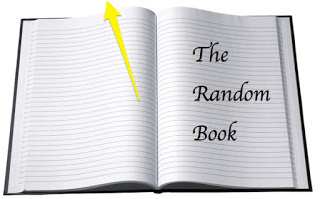 In the book I'm writing at the moment I'm considering the relationship of the arrow of time to entropy, the measure of the disorder in a system that comes out of the second law of thermodynamics. Entropy can be calculated by looking at the number of different ways to arrange the components that make up a system. The more ways there are to arrange them, the greater the entropy.
In the book I'm writing at the moment I'm considering the relationship of the arrow of time to entropy, the measure of the disorder in a system that comes out of the second law of thermodynamics. Entropy can be calculated by looking at the number of different ways to arrange the components that make up a system. The more ways there are to arrange them, the greater the entropy.As an example of why this is the case, I was talking about the letters that go together to make up that book, and the very specific arrangement of them required to be that actual book. Assuming that there will be about 500,000 characters including spaces in the book by the time it's finished, then there are 500,000! ways of arranging those characters. That's 500,000 factorial, which is 500,000x499,999x499,998x499,997... - rather a big number.
It's not practical to calculate the number exactly, but there are approximation techniques, and if the large factorial online calculator I found is correct, then 500,000! is around 1.022801584 x 102632341 - or to put it another way, around 1 with 2,632,341 zeros after it. That's a big number. By comparison there is just one way to arrange the letters to make my book*. So by producing the book I have vastly reduced the entropy. This seems to run counter to the second law of thermodynamics, which says that entropy in a closed system should stay the same or increase. But the clue is that get out clause, 'closed system'. The book isn't a closed system - the arrangement of the letters has come out of my head as a result of the consumption by my brain of a fair amount of energy. And it's that energy that makes the reduction in entropy possible.
Good stuff, but it shows that we shouldn't expect a room full of monkeys to come up with the complete works of Shakespeare - or my book - any time soon.
* This is only true if you consider each letter 'a' to be different from each other letter 'a' - imagine, for instance, each letter has a serial number. In that case it is literally true. In reality I could make what appears to be exactly the same book but swap all the letter 'a's with other letter 'a's and it would read exactly the same. And of course the same applies to every other letter. But there are still vastly fewer ways to organize those letters to spell out the same book than there are of producing any pattern whatsoever.
Published on September 18, 2015 01:28



